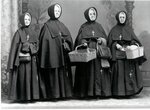
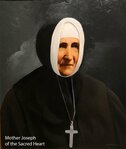
.jpg)
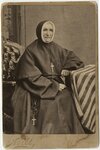
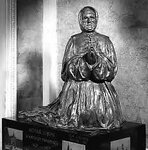
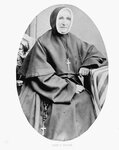
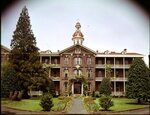
Today marks the 201st birthday of a Canadian woman whose loving selfless acts of service saved many lives throughout the Pacific Northwest.
Esther Pariseau was born April 16, 1823, on a farm near the city of Laval not far from Quebec, Canada, the third in a family of a dozen children, but she’s better remembered by her religious name — Mother Joseph of the Sacred Heart. The founder of the Northwest’s Sisters of Providence schools and hospitals throughout the Northwest was one of the Washington Women of Influence recently highlighted by Carol Irwin during a St. Helens Club lecture in Chehalis.
Although like most young girls in her day, Esther learned to sew, weave, card wool and tend house, according to a Providence article, “Pioneer, Leader, Woman of Faith,” she acquired skills in carpentry, design and construction while working with her father who built coaches. At 17, Esther attended a boarding school at St. Martin de Laval.
Three years later, in December 1843, she joined a newly founded Catholic religious community in Montreal called the Sisters of Providence led by Emilie Gamelin who focused on serving poor people inside the city.
When he dropped her off, her father, Joseph Pariseau, told Mother Gamelin, “I assure you, Madame, she will someday make a very good superior.”
Esther, a spirited woman with dark hair and gray eyes, trained as a nurse in the Sisters of Providence infirmary and pharmacy, sewed habits and vestments, created wax figures, helped the treasurer and assisted in baking, laundry, and other convent duties. Upon making her vows of poverty, chastity, obedience, and service to the poor on July 21, 1845, Esther received her religious name, Sister Joseph. She served as director of elderly women boarders, oversaw the financial accounts, and cared for ill nuns during typhus and cholera epidemics in Montreal during the late 1840s, including Mother Gamelin who died of cholera in 1851. The next year, she became assistant to Mother Caron, the new mother superior.
Only four years later, on Nov. 3, 1856, at the request of Bishop Augustin Magloire Alexandre Blanchet, Washington Territory’s first prelate, Sister Joseph left Montreal, leading a group of four Sisters of Providence to the newly formed territory in a quest to serve those living in harsh conditions. Their goal was to educate children and care for the poor and sick, sharing the love of Christ through their acts of service. Bishop Ignace Bourget of Montreal bestowed a new name on Esther, Mother Joseph of the Sacred Heart. The five nuns traveled around the Isthmus of Panama to Astoria and then up the Columbia River to Fort Vancouver, where they arrived on Dec. 8, 1856. They were housed in a one-room attic in the Bishop Augustin Blanchet’s home, but Mother Joseph quickly spearheaded construction of a 16-by-24-foot convent with a glass-paneled door and four windows.
Language proved a barrier initially as Mother Joseph spoke only French but needed to communicate in English, which two of the sisters could speak. The bishop gave the sisters two acres on the St. James Mission Claim where they erected a convent, novitiate, orphanage, and infirmary under the name of the Providence of the Holy Angels.
On April 14, 1857, in their convent cabin, the sisters opened a boarding school, which became known as Providence Academy in Vancouver. Mother Joseph kept a special spot in her heart for orphans, and within weeks of their arrival at Fort Vancouver, the sisters welcomed orphans into their care. Over the years, the sisters built several orphanages where abandoned or orphaned children could find a home.
Despite inner misgivings, Mother Joseph led the sisters as they purchased property away from the St. James Mission Claim and converted a small building into the Northwest’s first permanent hospital, St. Joseph Hospital, which opened on June 7, 1858. She incorporated the Sisters of Providence’s charitable works, including the school, orphanage, and hospital in 1859.
Their tireless work, traveling on horseback and by rivers, led to creation of nearly 30 hospitals, schools, and homes for orphans, the elderly, the sick, and the downtrodden throughout the west, including Washington, Oregon, Idaho, Montana, and southern British Columbia. The Sisters of Providence embarked on “begging tours,” seeking donations at mining and logging camps to cover their charitable expenses. More nuns traveled from Montreal to join the Providence of the West missions, which expanded to serve Native Americans in Montana.
After a decade as superior leading the Sisters of Providence in the West, Mother Joseph became treasurer and traveled the region to solicit donations and build more schools and hospitals, often spending time on construction sites to make sure everything was built to her satisfaction.
In 1873, Mother Joseph supervised construction of the four-story brick school and orphanage known as Providence Academy, which still stands in downtown Vancouver. Although the orphanage closed in the early 1900s, the school operated until 1966. Robert Hidden, whose grandfather made the bricks for the academy, and his family bought it to preserve the Gothic revival building. In 2015, the nonprofit Historic Trust of Vancouver purchased the 7-acre site containing the academy and other buildings.
Mother Joseph also oversaw construction of St. Joseph Hospital in Vancouver, today known as PeaceHealth Southwest Medical Center. The sisters prayed and dedicated themselves to serving, feeding, and caring for people who needed help.
Bishop Blanchet described Mother Joseph, who often strived for perfection, as pious, zealous, dedicated to good works, and well-intentioned but also “too hasty,” creating hardship for the sisters.
Although Mother Joseph suffered from breast cancer and underwent treatment in July 1899, she continued to travel to missions. However, after the tumor spread to her brain, causing her to lose sight in one eye, she retired to a room near Providence Academy and died Jan. 19, 1902, at 79. Her dying words to the sisters reflected the mission she pursued for nearly six decades: “My sisters, whatever concerns the poor is always our affair.”
Since 1980, her bronze statue, given to the National Statuary Hall Collection, has represented Washington state in Emancipation Hall of the U.S. Capitol Visitor Center in Washington, D.C. In 1999, at the request of Vancouver sixth graders, the Washington state Legislature passed a Senate Bill signed into law by Gov. Gary Locke that declared April 16 as Mother Joseph Day. She also was inducted into the Puget Sound Business Hall of Fame in 2002, according to a March 29, 2023, article in Northwest Catholic. She was buried near the rest of the sisters at St. James Acres, now Mother Joseph Cemetery in Vancouver, across from where my parents are buried. My dad wanted to be close to the nuns.
Next week I’ll discuss the history of local hospitals.
•••
Julie McDonald, a personal historian from Toledo, may be reached at memoirs@chaptersoflife.com.